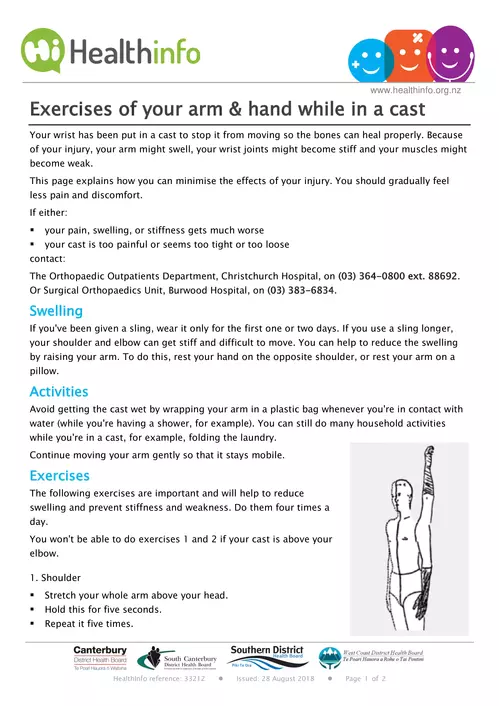
Exercises of your arm & hand while in a cast
Gently stretching after strengthening exercises can help reduce muscle soreness and keep your muscles long and flexible. Target Muscles: The muscle groups
adsPart of the document
Exercises of your arm & hand while in a cast
Your wrist has been put in a cast to stop it from moving so the bones can heal properly. Because
of your injury, your arm might swell, your wrist joints might become stiff and your muscles might
become weak.
This page explains how you can minimise the effects of your injury. You should gradually feel
less pain and discomfort.
If either:
your pain, swelling, or stiffness gets much worse
your cast is too painful or seems too tight or too loose
contact:
The Orthopaedic Outpatients Department, Christchurch Hospital, on (03) 364-0800 ext. 88692.
Or Surgical Orthopaedics Unit, Burwood Hospital, on (03) 383-6834.
Swelling
If you've been given a sling, wear it only for the first one or two days. If you use a sling longer,
your shoulder and elbow can get stiff and difficult to move. You can help to reduce the swelling
by raising your arm. To do this, rest your hand on the opposite shoulder, or rest your arm on a
pillow.
Activities
Avoid getting the cast wet by wrapping your arm in a plastic bag whenever you're in contact with
water (while you're having a shower, for example). You can still do many household activities
while you're in a cast, for example, folding the laundry.
Continue moving your arm gently so that it stays mobile.
Exercises
The following exercises are important and will help to reduce
swelling and prevent stiffness and weakness. Do them four times a
day.
You won't be able to do exercises 1 and 2 if your cast is above your
elbow.


